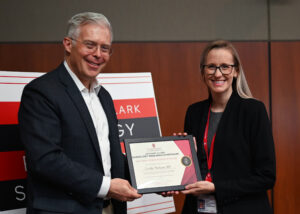
As the University of Wisconsin Department of Radiology gears up for this year’s Zachary Clark Research Radiology Symposium, Leslie Nelson, DO reflects upon her incredible year of achievements. As a fellow at last year’s symposium, she captivated the audience with her groundbreaking research on semaglutide therapy, earning the Best Oral Presentation award. Now, as an assistant professor with the department, she continues to make significant advances in the research world, while also mentoring future radiologists.
Career Beginnings
Leslie Nelson grew up in nearby Oregon, Wisconsin and in 2012 she obtained her undergraduate degree from UW–Madison before heading south for medical training. In 2018, Dr. Nelson received her medical degree from Lincoln Memorial University in Harrogate, Tennessee and then completed her internship in general surgery and diagnostic radiology residency at the University of Kentucky in Lexington, Kentucky.
Returning north in 2023, Dr. Nelson joined the department as an Abdominal Imaging and Intervention fellow and then a faculty member in the Section of Abdominal Imaging and Intervention.
Groundbreaking Research as a Fellow
As a fellow with Perry Pickhardt, MD’s mentorship, Dr. Nelson began researching how CT-based AI tools could visualize biomarkers of body composition changes in patients using semaglutide (also known under the brand names Ozempic, Wegovy, or Rybelsus). In addition to Dr. Pickhardt, faculty members Matthew Lee, MD; John Garrett, PhD; and Joshua Warner, MD, PhD contributed to her research as did Research Assistant Silas Pickhardt and Ronald Summers, MD, PhD from the NIH Clinical Center.
For the retrospective study, she reviewed data from 241 patients who had underwent abdominopelvic CT scans both within five years before and within five years after beginning semaglutide use. She and the team looked for changes in visceral adipose tissue (VAT), subcutaneous adipose tissue (SAT), intermuscular adipose tissue (IMAT) area, liver volume, and other markers.
Patients who had lost weight while using semaglutide showed decreases in VAT, SAT, muscle area, and liver volume, and an increase in liver attenuation. The weight gain group showed an increase in VAT, SAT, and IMAT, and a decrease in muscle attenuation.
The research team concluded that semaglutide therapy leads to patterns of body composition changes, with potential implications for cardiometabolic risk. The team also acknowledged that the readings were beyond what can be measured in a clinical setting, such as recording the patients’ weight or waist circumference. These kinds of readings could prove essential in understanding how medications like semaglutide can impact the body before and after treatment but can also provide suggestions for lifestyle modification that can help improve the quality of life for patients.
Recognition for Research

While she was still a fellow, Dr. Nelson presented her research at the 2024 Zachary Clark Radiology Research Symposium and secured the Best Oral Presentation by a Fellow award.
“The Zachary Clark Research Symposium is an excellent event to showcase the hard work of the trainees and some of the innovative research performed at the University of Wisconsin Department of Radiology,” said Dr. Nelson. “I was honored to present our research and receive the award. It was very meaningful to share our project with the Department of Radiology, which we worked hard on throughout my fellowship.”
The research was later published by the American Journal of Roentgenology (AJR) on September 4, 2024 and quickly garnered additional attention. It was highlighted by AuntMinnie in an article from September 11, 2024. The paper also received the Best of AJR Award in the Multispecialty section in December 2024.
In addition, AJR also included it as part of the “Study Guide for “Intrapatient Changes in CT-Based Body Composition After Initiation of Semaglutide (Glucagon-Like Peptide-1 Receptor Agonist) Therapy.” A monthly feature by the publication, the study guides are designed to help build skills in evidence-based radiology. In a way, this brings it full circle where the research she developed with the support of mentors is now used to help future radiologists.
“The mentorship I have received from the Department of Radiology has been the driving force behind our success, especially from Perry Pickhardt, MD,” said Dr. Nelson. “The mentorship from our co-authors, Matthew Lee, MD; John Garrett, PhD; and Joshua Warner, MD, PhD also helped guide and inspire me as an early career researcher.”
What Lies Ahead
Now a faculty member, Dr. Nelson continues to pursue a variety of research topics. Most recently, she was the first author for “Spectrum of Heterotopic and Ectopic Splenic Conditions,” which was finalized in November 2024 in RadioGraphics. She also collaborated with peers from other institutions on “Contrast-enhanced ultrasound of renal masses in the pre-transplant setting: literature review with case highlights,” which was finalized in December 2024 in Abdominal Radiology.

Mentors and peers have played a pivotal role in her advancements and Dr. Nelson is committed to helping young radiologists as well. She is the co-chair of Women Professionals in Radiology which hosts events to support female faculty and nurture connections, such as this past fall’s Radiology Roundtable: Jeopardy & Mentorship Night. About 40 medical students attended this event and had the opportunity to participate in small group discussions as well as a speed networking activity.
Dr. Nelson’s career interests include expanding her upcoming research projects and continuing to contribute to the future of radiology. Based on the accolades for her findings on semaglutide as a fellow, Dr. Nelson’s work as a faculty member will likely bring even more recognition.